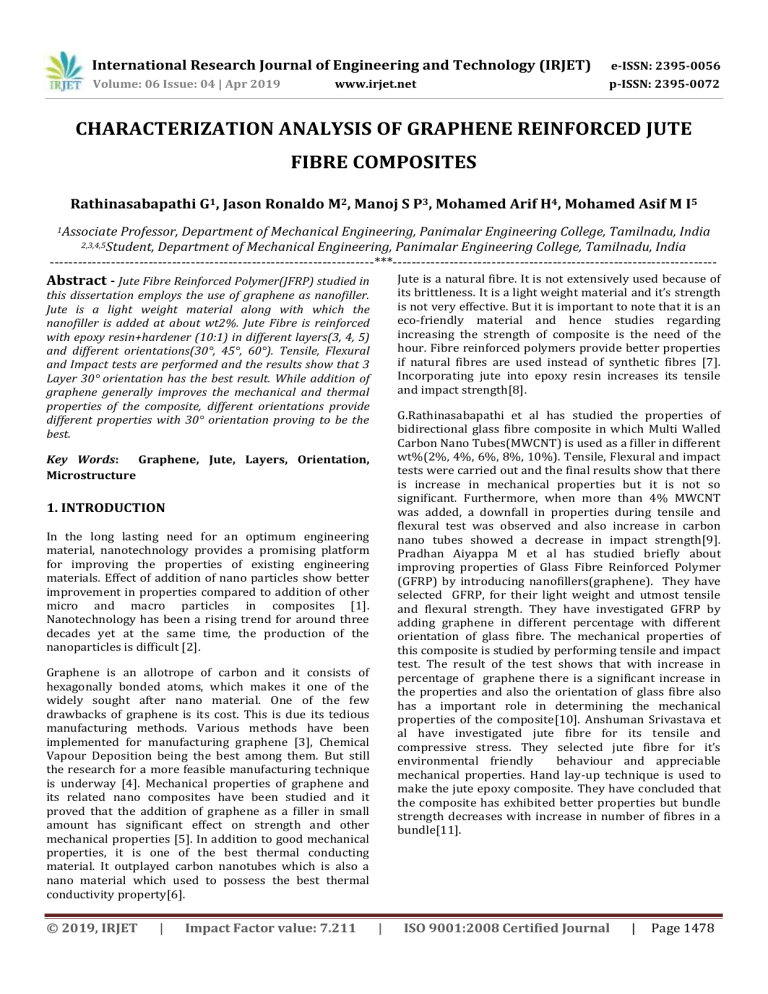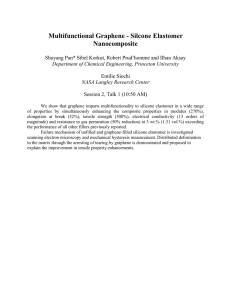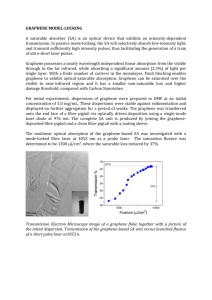IRJET-Characterization Analysis of Graphene Reinforced Jute Fibre Composites
advertisement

International Research Journal of Engineering and Technology (IRJET) e-ISSN: 2395-0056 Volume: 06 Issue: 04 | Apr 2019 p-ISSN: 2395-0072 www.irjet.net CHARACTERIZATION ANALYSIS OF GRAPHENE REINFORCED JUTE FIBRE COMPOSITES Rathinasabapathi G1, Jason Ronaldo M2, Manoj S P3, Mohamed Arif H4, Mohamed Asif M I5 1Associate Professor, Department of Mechanical Engineering, Panimalar Engineering College, Tamilnadu, India Department of Mechanical Engineering, Panimalar Engineering College, Tamilnadu, India ---------------------------------------------------------------------***--------------------------------------------------------------------Jute is a natural fibre. It is not extensively used because of Abstract - Jute Fibre Reinforced Polymer(JFRP) studied in 2,3,4,5Student, its brittleness. It is a light weight material and it’s strength is not very effective. But it is important to note that it is an eco-friendly material and hence studies regarding increasing the strength of composite is the need of the hour. Fibre reinforced polymers provide better properties if natural fibres are used instead of synthetic fibres [7]. Incorporating jute into epoxy resin increases its tensile and impact strength[8]. this dissertation employs the use of graphene as nanofiller. Jute is a light weight material along with which the nanofiller is added at about wt2%. Jute Fibre is reinforced with epoxy resin+hardener (10:1) in different layers(3, 4, 5) and different orientations(30°, 45°, 60°). Tensile, Flexural and Impact tests are performed and the results show that 3 Layer 30° orientation has the best result. While addition of graphene generally improves the mechanical and thermal properties of the composite, different orientations provide different properties with 30° orientation proving to be the best. G.Rathinasabapathi et al has studied the properties of bidirectional glass fibre composite in which Multi Walled Carbon Nano Tubes(MWCNT) is used as a filler in different wt%(2%, 4%, 6%, 8%, 10%). Tensile, Flexural and impact tests were carried out and the final results show that there is increase in mechanical properties but it is not so significant. Furthermore, when more than 4% MWCNT was added, a downfall in properties during tensile and flexural test was observed and also increase in carbon nano tubes showed a decrease in impact strength[9]. Pradhan Aiyappa M et al has studied briefly about improving properties of Glass Fibre Reinforced Polymer (GFRP) by introducing nanofillers(graphene). They have selected GFRP, for their light weight and utmost tensile and flexural strength. They have investigated GFRP by adding graphene in different percentage with different orientation of glass fibre. The mechanical properties of this composite is studied by performing tensile and impact test. The result of the test shows that with increase in percentage of graphene there is a significant increase in the properties and also the orientation of glass fibre also has a important role in determining the mechanical properties of the composite[10]. Anshuman Srivastava et al have investigated jute fibre for its tensile and compressive stress. They selected jute fibre for it’s environmental friendly behaviour and appreciable mechanical properties. Hand lay-up technique is used to make the jute epoxy composite. They have concluded that the composite has exhibited better properties but bundle strength decreases with increase in number of fibres in a bundle[11]. Key Words: Graphene, Jute, Layers, Orientation, Microstructure 1. INTRODUCTION In the long lasting need for an optimum engineering material, nanotechnology provides a promising platform for improving the properties of existing engineering materials. Effect of addition of nano particles show better improvement in properties compared to addition of other micro and macro particles in composites [1]. Nanotechnology has been a rising trend for around three decades yet at the same time, the production of the nanoparticles is difficult [2]. Graphene is an allotrope of carbon and it consists of hexagonally bonded atoms, which makes it one of the widely sought after nano material. One of the few drawbacks of graphene is its cost. This is due its tedious manufacturing methods. Various methods have been implemented for manufacturing graphene [3], Chemical Vapour Deposition being the best among them. But still the research for a more feasible manufacturing technique is underway [4]. Mechanical properties of graphene and its related nano composites have been studied and it proved that the addition of graphene as a filler in small amount has significant effect on strength and other mechanical properties [5]. In addition to good mechanical properties, it is one of the best thermal conducting material. It outplayed carbon nanotubes which is also a nano material which used to possess the best thermal conductivity property[6]. © 2019, IRJET | Impact Factor value: 7.211 | ISO 9001:2008 Certified Journal | Page 1478 International Research Journal of Engineering and Technology (IRJET) e-ISSN: 2395-0056 Volume: 06 Issue: 04 | Apr 2019 p-ISSN: 2395-0072 www.irjet.net where P is the break load, L is the support span, b is the specimen width and t is the specimen thickness respectively. 2. EXPERIMENTATION: 2.1 MATERIAL: Graphene powder with minimum purity of 99% having flake size of 6μm and a flake thickness of 0.7-7 nm were used. A low viscosity epoxy resin (Density: 1.2 g/cm3) is mixed with Hardener HY951. Bi-directional jute (Density = 1.3g/cm3, Young's Modulus = 26.5GPa) is chosen for fibre reinforcement. Fig-2: Flexural Test Specimen 2.2 PREPARATION OF JFRP: 2.5 IMPACT TEST: Initially Low Yield Epoxy Resin is mixed with Hardener HY951 in 10:1 ratio. Graphene is added into the mixture at wt2%. After fine stirring, the mixture is ready for layering. Mould is cleaned properly with silicon spray and a polyester sheet is added at the base before layering. Now a layer of Epoxy mixture (Epoxy + Graphene) is poured over it. Jute fibre is then placed with required orientations above it. This process is repeated for different layers and orientations, Then the entire composite setup is compressed uniformly at 5 bar pressure for 7 hours in open air. 9 distinct plates with different layers and orientations are obtained which is then cut into required ASTM standard dimensions. Impact test was conducted as per ASTM D256 standard. IZOD method is employed for impact testing. The standard specimen used for test was 70mm × 15mm × 3mm. Fig-3: Impact Test Specimen 2.3 TENSILE TEST: 3. RESULTS AND DISCUSSIONS: Specimens were cut as per ASTM D638 standard and this test is carried out in Universal Testing Machine. For each arrangement, 3 identical specimens were tested and the average result is obtained. Fractural Toughness was calculated using the equation. 3.1 TENSILE TEST: Tensile test was carried out in a universal testing machine for the 9 specimens and the results are tabulated below 2 Fractural Toughness = a Sl. No E where σ is Stress (N/mm2), a is the Crack Length and E, the Young’s Modulus respectively. Fig-1: Tensile Test Specimen Flexural Strength = 3PL 2bt 2 © 2019, IRJET | Impact Factor value: 7.211 Percentage Elongation (%) Peak load (KN) UTS (N/ ) FRACTURE TOUGHNESS (N/mm) 1. 3 LAYER 30º 14.85 2.60 36.62 237.7 2. 4 LAYER 30º 13.78 2.54 34.89 194.10 3. 5 LAYER 30º 13.95 3.12 39.4 224.7 4. 3 LAYER 45º 9.12 1.48 23.49 80.89 5. 4 LAYER 45º 11.83 1.92 29.11 142.93 6. 5 LAYER 45º 7.28 1.67 18.72 58.68 7. 3 LAYER 60º 10.07 1.77 28.6 108.52 8. 4 LAYER 60º 16.12 1.4 18.09 120.17 9. 5 LAYER 60º 13.7 2.14 29.16 188.91 2.4 FLEXURAL TEST: Flexural Tests were performed on a universal testing machine according to ASTM D790 standard. This test is done to assess the stiffness of the material. Specimens of 127mm length, 13mm wide and 3.2mm thickness were cut and tested. Flexural Strength was calculated using the equation, Composition Table-1: Tensile test reports | ISO 9001:2008 Certified Journal | Page 1479 International Research Journal of Engineering and Technology (IRJET) e-ISSN: 2395-0056 Volume: 06 Issue: 04 | Apr 2019 p-ISSN: 2395-0072 www.irjet.net This study depends on two noteworthy parameters. They are based on orientations of jute fiber (30°,45°,60°) and the number of layers of jute in JFRP (3,4,5). From the studied data, it can be found that 30° orientation shows better flexural strength than 45° and 60° orientations. 45° orientation specimens show weaker results but 60° orientations shows better results than that of 45°. This trend seems to occur in specimens 3 layer, 4 layer and 5 layer. Flexural Strength variation based on Number of Layers Ultimate Tensile Strength variation based on Number of 45 Layers 40 35 30 25 20 15 10 5 0 30° 45° 60° 3 Layer 36.62 23.49 28.6 4 Layer 34.89 29.11 18.09 5 Layer 39.4 18.72 29.16 45 Flexural Strength (N/mm2) Ultimate Tensile Strength (N/mm 2) This comparison is based on two major parameters. They are on the basis of orientations of jute fibre (30°,45°,60°) and the number of layers of jute in JFRP (3,4,5). From the studied data, it can be found that 30° orientation shows better tensile strength than 45° and 60° orientations. 45° orientation specimens show weaker results but 60° orientations shows better results than that of 45°. This trend seems to occur in different layer specimens. 25 20 15 10 5 30° 45° 60° 3 Layer 36.2 28.43 33.1 4 Layer 38.7 34 30 5 Layer 20.3 31.7 29.5 3.3 IMPACT TEST: Flexural test was carried out in a Flexural testing machine for the 9 specimens and the results are tabulated below Ultimate/ Break load (KN) Displacement At Fmax (mm) Ultimate Stress (KN/mm2) Flexural Strength (N/mm2) 3 LAYER 30° 0.185 2.400 0.003 2. 4 LAYER 30° 0.235 2.300 3. 5 LAYER 30° 0.145 4. 3 LAYER 45° 5. 1. 30 Fig-5: Flexural Strength based on Number of Layers 3.2 FLEXURAL TESTS: Composition 35 0 Fig-4: Tensile Strength based on Number of Layers Sl. No 40 Impact test was carried out in a Impact testing machine for the 9 specimens and the results are tabulated below Sample I.D Values in Joules 36.2 3 layer 30° 8.0 0.003 38.7 3 layer 45° 6.2 1.700 0.002 20.3 3 layer 60° 5.4 0.220 2.000 0.002 28.43 4 layer 30° 4.8 4 LAYER 45° 0.200 2.600 0.002 34 4 layer 45° 4.0 6. 5 LAYER 45° 0.265 2.300 0.003 31.7 4 layer 60° 3.2 7. 3 LAYER 60° 0.185 2.900 0.002 33.1 5 layer 30° 3.9 8. 4 LAYER 60° 0.270 1.600 0.003 30 5 layer 45° 3.1 9. 5 LAYER 60° 0.175 2.100 0.002 29.5 5 layer 60° 2.1 Table-3: Impact test report Table-2: Flexural test reports © 2019, IRJET | Impact Factor value: 7.211 | ISO 9001:2008 Certified Journal | Page 1480 International Research Journal of Engineering and Technology (IRJET) e-ISSN: 2395-0056 Volume: 06 Issue: 04 | Apr 2019 p-ISSN: 2395-0072 www.irjet.net Impact test results show that the Impact energy of the specimens decrease with an increase in orientation. The same pattern is seen with the increase in jute fibre layers in the JFRP. From the tabulated data it can be inferred that 3 layer 30° shows the best results and the impact energy decrease for 45° and 60° orientations. Among the same orientations, the impact energy decreases with increase in ply. graphene filler is not dispersed uniformly throughout. Agglomeration of fillers might result in poor mechanical properties. Due to agglomeration, the load carrying capability of the composite decreases. VALUES IN JOULES 9 8 7 6 5 4 3 2 1 0 30° 3 Layer 8 4 Layer 4.8 5 Layer 3.9 45° 60° 6.2 4 3.1 5.4 3.2 2.1 Fig-8: River Lines in JFRP Fig-6: Impact Strength based on Number of Layers MICROSTRUCTURAL FEATURES: Fig-9: Agglomeration in JFRP 4. CONCLUSIONS: Fig-7: Fibre pull out in JFRP The continuous study of JFRP with various fibre orientations and layers give different properties. Generally, JFRP is used to replace the metal with lesser weight but equal in strength to the metals. In order to further improve the strength of JFRP here, we made a composite of JFRP incorporated with graphene with various Jute fibre orientations and tested to obtain the above values and completed our study on JFRP with graphene. The rough surface does not allow the matrix to stick on to the fibre firmly. This may cause poor adhesion at the interface between fibre and surface. From the micrograph, it is clear that the fibre surfaces are smooth, this aids in improving the interface adhesion. The improvement in the interface adhesion due to the smooth fibre surface is evident in the improved properties attained. Fig.8 shows the river lines which is due to the application of load and initiate crack. Fig.9 shows that the © 2019, IRJET | Impact Factor value: 7.211 From the study 3 layer 30° orientation JFRP with 2% graphene gives a higher stress-strain value and is | ISO 9001:2008 Certified Journal | Page 1481 International Research Journal of Engineering and Technology (IRJET) e-ISSN: 2395-0056 Volume: 06 Issue: 04 | Apr 2019 p-ISSN: 2395-0072 www.irjet.net Laminates, International Journal of Engineering Research & Technology (IJERT); ISSN: 2278-0181 ,Vol. 5 Issue 07, July-2016, http://dx.doi.org/10.17577/IJERTV5IS070420. [11] Kumar, Asheesh & Srivastava, Anshuman. (2017), Preparation and Mechanical Properties of Jute Fibre Reinforced Epoxy Composites. Industrial Engineering & Management, 06. 10.4172/21690316.1000234. recommended for higher strength, while 45° and 60° orientation specimens resulted in lower stress-strain values due to fibre pull out. Thus, the conclusion proved that the 30° orientation reduced the brittleness property of composite and increases the tensile and flexural strength. REFERENCES [1] [2] [3] [4] [5] [6] [7] [8] [9] [10] Christian , F. Von der Kammer,M. Baalousha, Th. Hofmann; Nanoparticles: structure, properties, preparation and behaviour in environmental media;14 April 2008 Springer Science+Business Media, LLC 2008, DOI 10.1007/s10646-008-0213-1. Costas A. Charitidis, Pantelitsa Georgiou, Malamatenia A. Koklioti, Aikaterini-Flora Trompeta, and Vasileios Markakis; Manufacturing nanomaterials: from research to industry; Manufacturing Rev. 2014, 1, 11, DOI: 10.1051/mfreview/2014009. Edward P. Randviir, Dale A.C. Brownson and Craig E. Banks; A Decade of Graphene Research:Production, Applications and Outlook; Materials Today Volume 17, Number 9 November 2014, http://dx.doi.org/10.1016/j.mattod.2014.06.001. Cheun Lee, Wei-Wen Liu, Siang-Piao Chai, Abdul Rahman Mohamed, Chin Wei Lai, Cheng-Seong Khe, C.H.Voon, U. Hashim, N.M.S. Hidayah; Synthesis of Single-layer Graphene: A Review of Recent Development; Procedia Chemistry 19 (2016) 916 – 921, doi:10.1016/j.proche.2016.03.135. Dimitrios G. Papageorgiou , Ian A. Kinloch, Robert J. Young; Mechanical properties of graphene and graphene-based nanocomposites; 2017 The Authors. Published by Elsevier Ltd., http://dx.doi.org/10.1016/j.pmatsci.2017.07.004 0079-6425/ 2017. Alexander A. Balandin, Suchismita Ghosh, Wenzhong Bao, Irene Calizo, Desalegne Teweldebrhan, Feng Miao, and Chun Ning Lau; Superior Thermal Conductivity of Single-Layer Graphene; Nano Lett., Vol. 8, No. 3, 2008, 10.1021/nl073187. Harpreet Singh, Jai Inder Preet Singh,Sehijpal Singh , Vikas Dhawan, Sunil Kumar Tiwari; A Brief Review of Jute Fibre and Its Composites; Materials Today: Proceedings 5 (2018) 28427–28437, www.materialstoday.com/proceedings. Satyendra Pratap Singh Yadav, Dr. A.S. Verma; Fabrication of composite material using Jute fiber/Glass fiber, International Research Journal of Engineering and Technology (IRJET), Volume: 04 Issue: 08, 892-896, Aug 2017, www.irjet.net. G.Rathinasabapathi and A.Krishmamoorthy, Performance characteristics of multiwalled carbon nanotubes (mwcnt) incorporated with glass fibre reinforced composites, International Journal of Mechanical Engineering and Technology (IJMET) Volume 9, Issue 5, May 2018, pp. 445–453, Article ID: IJMET_09_05_048 http://www.iaeme.com/ijmet/issues.asp?JType=IJME T&VType=9&IType=5. Pradhan Aiyappa M R, Sunith Babu L Studies on Mechanical Properties of Graphene based GFRP © 2019, IRJET | Impact Factor value: 7.211 | ISO 9001:2008 Certified Journal | Page 1482




